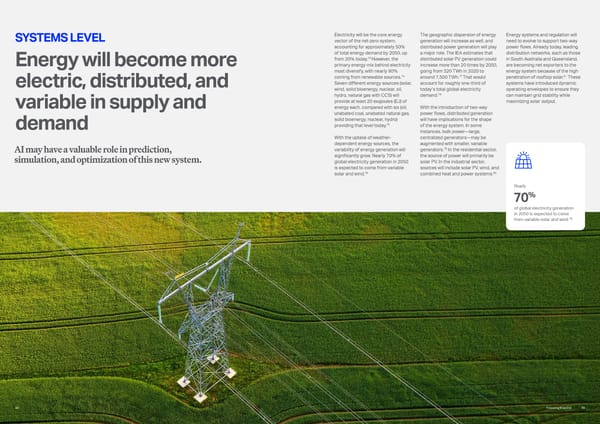Energy will become more electric, distributed, and variable in supply and demand Electricity will be the core energy vector of the net-zero system, accounting for approximately 50% of total energy demand by 2050, up from 20% today.73 However, the primary energy mix behind electricity must diversify, with nearly 90% coming from renewable sources.74 Seven different energy sources (solar, wind, solid bioenergy, nuclear, oil, hydro, natural gas with CCS) will provide at least 20 exajoules (EJ) of energy each, compared with six (oil, unabated coal, unabated natural gas, solid bioenergy, nuclear, hydro) providing that level today.75 With the uptake of weather- dependent energy sources, the variability of energy generation will significantly grow. Nearly 70% of global electricity generation in 2050 is expected to come from variable solar and wind.76 SYSTEMS LEVEL The geographic dispersion of energy generation will increase as well, and distributed power generation will play a major role. The IEA estimates that distributed solar PV generation could increase more than 20 times by 2050, going from 320 TWh in 2020 to around 7,500 TWh.77 That would account for roughly one-third of today’s total global electricity demand.78 With the introduction of two-way power flows, distributed generation will have implications for the shape of the energy system. In some instances, bulk power—large, centralized generators—may be augmented with smaller, variable generators.79 In the residential sector, the source of power will primarily be solar PV. In the industrial sector, sources will include solar PV, wind, and combined heat and power systems.80 Energy systems and regulation will need to evolve to support two-way power flows. Already today, leading distribution networks, such as those in South Australia and Queensland, are becoming net exporters to the energy system because of the high penetration of rooftop solar.81 These systems have introduced dynamic operating envelopes to ensure they can maintain grid stability while maximizing solar output. AI may have a valuable role in prediction, simulation, and optimization of this new system. Nearly of global electricity generation in 2050 is expected to come from variable solar and wind 76 70% 50 Powering Possible 49
 Powering Possible 2024: AI and Energy for a Sustainable Future Page 25 Page 27
Powering Possible 2024: AI and Energy for a Sustainable Future Page 25 Page 27